
Canon 200mm F2 vs Sony 135mm f1.8 Camera Lens Bokeh Test Comparison Video.
In the world of professional photography, the lens you choose can make or break the final result. With many options available on the market, it can be challenging to decide which lens best suits a particular need. Today, we’re pitting two high-performance prime lenses against each other: Canon’s 200mm f/2.0 and Sony’s 135mm f/1.8. Each lens offers distinct advantages, and this comparison will help photographers make an informed decision.
1. Focal Length and Field of View
Canon 200mm f/2.0: With a 200mm focal length, this lens is firmly in the telephoto category. It’s suitable for capturing subjects from a distance, making it a preferred choice for wildlife, sports, and some portraiture scenarios where isolation of the subject from the background is a priority.
Sony 135mm f/1.8: This lens sits in between a standard and telephoto focal length. It’s a popular choice for portrait photographers due to its ability to deliver a flattering perspective without severe compression. It’s also more versatile than the Canon 200mm in terms of general usage.
The video below compares the Canon 200mm F2 vs Sony 135mm f1.8 but we also get a look at how well an 85mm f1.2 and a 105mm f1.4 do together. Thanks to Many Ortiz for the great video.
You can find the Sony 135mm for sale here and the Canon 200mm f2 here at a fare price.
2. Aperture
Canon 200mm f/2.0: A fast f/2.0 aperture allows for substantial light intake, which is beneficial in low light conditions. It also provides a very shallow depth of field, offering a dreamy bokeh effect.
Sony 135mm f/1.8: Slightly faster at f/1.8, the Sony lens also offers excellent performance in low light and has the ability to produce a similarly smooth bokeh. The difference in aperture between the two lenses is minimal but could be a deciding factor for those looking for the absolute best in low-light performance.
3. Build Quality and Handling
Canon 200mm f/2.0: Canon’s lens is robust and well-built, but it’s also significantly heavier due to its larger glass elements and metal construction. This might make it less appealing for photographers who need to be mobile or those shooting without a tripod.
Sony 135mm f/1.8: Sony’s offering is more compact and lighter than the Canon. The design is sleek, with high-quality materials ensuring longevity. It’s easier to handle, especially for extended shooting periods.
4. Image Quality and Optical Performance
Canon 200mm f/2.0: This lens is renowned for its razor-sharp image quality, even wide open. Color reproduction is vibrant, and the lens controls aberrations well. Its telephoto nature and the f/2.0 aperture combine to produce an almost three-dimensional effect on subjects.
Sony 135mm f/1.8: Sony’s lens also delivers sharp, clear images with minimal optical distortions. The color rendition is neutral and accurate. While the background separation is fantastic, it might not offer the same three-dimensional pop as the Canon due to its shorter focal length.
5. Autofocus
Canon 200mm f/2.0: Canon’s USM (Ultrasonic Motor) ensures fast and silent autofocus. The accuracy is commendable, even in challenging lighting conditions.
Sony 135mm f/1.8: Sony’s lens employs its Direct Drive SSM (Super Sonic wave Motor) which is swift and precise. Given Sony’s mirrorless technology, photographers might also benefit from features like Eye AF when using this lens with compatible Sony cameras.
6. Compatibility and Mount
Canon 200mm f/2.0: Canon’s lens is designed for their EF mount. However, it can be used on mirrorless bodies like the EOS R series with an adapter.
Sony 135mm f/1.8: Tailored for Sony’s E-mount, this lens is primarily for their mirrorless range. It seamlessly integrates with Sony’s camera features and tech.
7. Price
Both lenses are premium offerings, and their prices reflect that. The Canon 200mm f/2.0, due to its unique focal length and large aperture, tends to be more expensive. The Sony 135mm f/1.8 is also priced at the higher end but might be more affordable than the Canon for some buyers.
The Wrap-Up
Choosing between the Canon 200mm f/2.0 and the Sony 135mm f/1.8 boils down to specific needs and preferences. If you’re seeking an ultra-telephoto lens with exceptional image quality and don’t mind the weight, Canon’s lens might be the pick. However, if you want a versatile lens that’s great for portraits and general photography while being lighter and slightly more affordable, Sony’s offering could be the winner.
Both lenses uphold the reputation of their respective brands and promise outstanding results in the right hands. Consider your primary subjects, shooting style, and equipment budget, and you’ll find the perfect match!